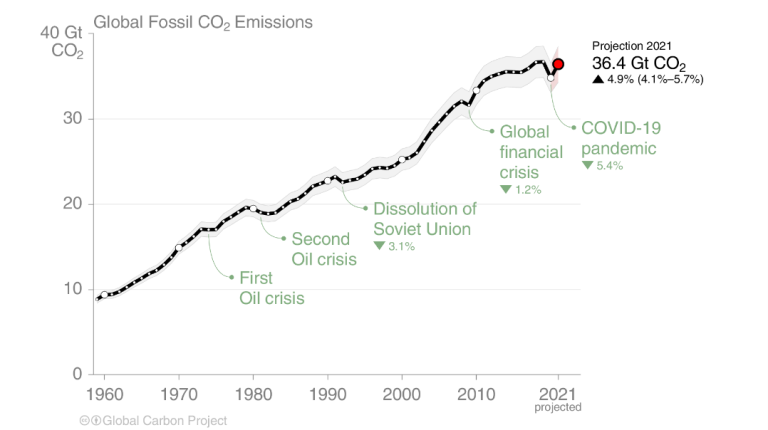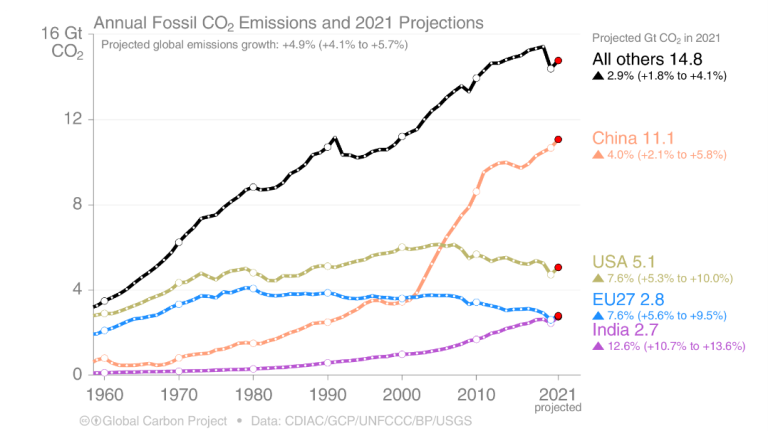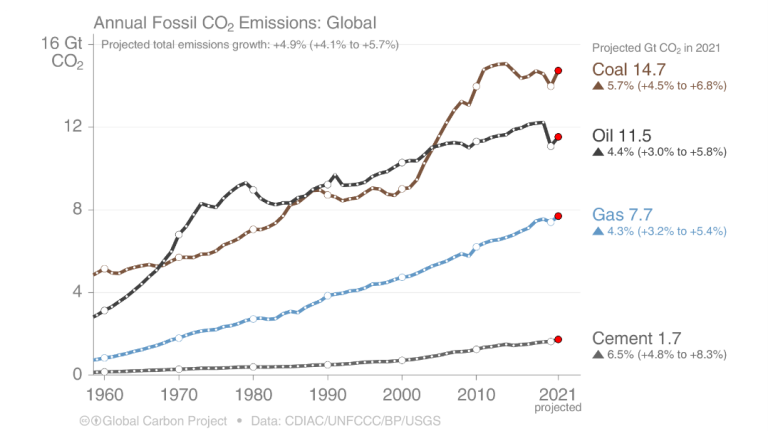Global co₂ emissions return to near pre-COVID pandemic levels
Global fossil co₂ emissions are expected to grow 4.9% in 2021, nearly offsetting the 5.4% decline in 2020 due the COVID restrictions. Coal and gas use rebounded strongly to exceed 2019 levels, while oil use remains suppressed, suggesting strong policy action is needed to avoid continued emissions growth in 2022.
Today, 4 November, the Global Carbon Project (GCP) publishes a preprint of its annual analysis of trends in the global carbon cycle in the journal Earth System Science Data, including an updated full-year projection of global fossil carbon dioxide (CO2) emissions in 2021.

Global fossil CO2 emissions are expected to grow 4.9% (with an uncertainty range of 4.1% to 5.7%) in 2021, recovering most of the 5.4% decline in 2020 due to the restrictions in place across the globe to slow the spread of coronavirus (COVID). Global fossil CO2 emissions are now less than 1% below their 2019 levels.
- CO2 emissions from coal use are expected to grow 5.7% [4.5% to 6.8%], exceeding 2019 levels by 1%. Another year of modest growth would push CO2 emissions from coal use above their peak in 2014.
- CO2 emissions from gas use are expected to grow 4.3% [3.2% to 5.4%], exceeding 2019 levels by nearly 2%, and putting gas back on its long-term growth trajectory.
- CO2 emissions from oil use are expected to grow 4.4% [3.0% to 5.8%], but due to a large decline in 2020, will remain below 2019 levels by almost 6%. If coal use is stable and gas use grows in 2022, then a further recovery in oil use to near 2019 levels would imply robust growth of fossil CO2 emissions again in 2022.
Were emissions approaching a peak?
Despite the tragedy of the COVID pandemic in 2020, the strength and nature of the rebound in fossil CO2 emissions shows the world has done little to focus on a green recovery,” said Glen Peters, a research director at the CICERO Center for International Climate Research in Norway.

“The discussion in 2019 was increasingly on a potential peak in fossil CO2 emissions as the climate transition sped up, but with oil demand still supressed, indications are that there is yet more CO2 growth to come,” said Peters.
Some sort of rebound in fossil CO2 emissions was expected during 2021 as COVID restrictions were gradually lifted around the world. The size of the rebound was larger than many may have anticipated.
“China had a potential peak in coal use in 2013 and declining CO2 emissions from 2014 to 2016, but China has shown robust emissions growth since 2016, including through most of the COVID pandemic”, said Jan Ivar Korsbakken, a senior researcher at CICERO.
If emissions from Chinese coal use grows 2.5% this year as expected in our projection (range of 0.9% to 3.9%), then this will exceed their 2013 peak.
The US and EU27 are both expected to have strong rebounds in fossil CO2 emissions of 7.6% in 2021, but this growth only partially offsets the declines in 2020 (around 10%) and puts these countries back on their moderately declining emission trends.
India’s fossil CO2 emissions are expected to rebound by 12.6% [10.7% to 13.6%] in 2021, 4.4% above 2019 levels. Indian coal use is expected to grow around 15% in 2021, wiping out any hint of a slowdown in coal use.
Our 2021 emission projection are based on the use of monthly data.
“Most big emitters publish monthly statistics on fossil fuel use or supply, which allows us to projection CO2 emissions in the months with data and make assumptions about what happens in the last few months of the year to get a projection,” said senior researcher Robbie Andrew from CICERO.
“Our approach is to stay as close as possible to reported direct fuel use to limit the assumptions we have to make, but even official monthly data are subject to revision, and caution should be taken with over-interpreting projections,” continued Andrew.

Continued growth in emissions drives increases in atmospheric concentrations
This year’s global carbon budget has a major revision of CO2 emissions from land-use change which brings three independent estimates closer together, but with uncertainties remaining. CO2 emissions from land-use change now show a declining trend in the last decade, instead of an increasing trend in earlier budgets.
When combining CO2 emissions from fossil sources and land-use change, total emissions have remained relatively flat in the last decade (2011-2020), averaging 39.7 GtCO2, and are projected to be 39.4 GtCO2 in 2021.
Atmospheric CO2 concentrations have increased on average 2.5 parts per million (ppm) per year in the last five years. The increase in 2020 was 2.4 ppm with an expected increase of 2.0 ppm in 2021, bringing the average concentration in 2021 to 415 ppm, 49% over the preindustrial level.
“The climate system is driven by the total amount of CO2 put in the atmosphere, with interannual variability having an important modulating role,” said Peters.
“Global warming stops when emissions get to around zero,” he added.
.jpg&w=3840&q=100)